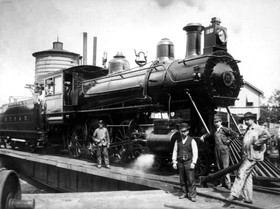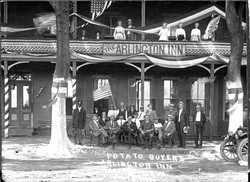This entry includes a walking tour! Take the tour.
Introduction
Text-to-speech Audio
Images
1902 Baldwin Locomotive at Cape Charles

Potato Buyers at Arlington Inn, 1912

Backstory and Context
Text-to-speech Audio
The town of Cape Charles was born suddenly in 1884, after a wooded marshy area was selected by two wealthy and powerful businessmen from Pennsylvania to be the site of a direct overwater railroad connection between Norfolk and the lower Delmarva Peninsula. By avoiding the costly and time consuming process of unloading and reloading freight between railroad cars and steamers, this route would provide an efficient alternative to the east coast mainland rail line, linking the northern cities of Philadelphia and New York with Norfolk and the south via the Eastern Shore.
The project required extending the existing railroad line south from Pocomoke MD to Cape Charles, and creating a harbor with “float bridge” docks by means of which the fully loaded railroad cars could be moved from the end of the tracks onto “car floats” to travel across the Bay to Norfolk, where they would again be connected to locomotives. The car floats, later called barges, had from one to four sets of parallel tracks, and were pulled by tugs. For passenger traffic, “railroad transfer steamers” were designed to accommodate Pullman cars, so that passengers from New York could have a through passage all the way to Norfolk.
The two men, Alexander J. Cassatt (1839-1906) a vice-president of the Pennsylvania Railroad (PRR), and William L. Scott (1828-1891), a coal and railroad magnate, raised the capital, laid out the rail line, started the town, dredged the harbor, built the first railroad yards, and formed the New York, Philadelphia & Norfolk Railroad (NYP&N) in 1884 to run the operation. In 1899 Cassatt became president of the PRR. The NYP&N was highly profitable into the 1920s and was acquired by the PRR in 1922.
The town was a busy place for many years: four trains a day from NY, with automobile ferries added in 1931. But in 1950 the ferries moved to Kiptopeke Terminal seven miles south; Pennsylvania RR steamer service ceased in 1953, passenger trains in 1958. Freight passage via the link to tug and railroad barge ceased in 2009.
The architecture of Cape Charles houses has surprising aesthetic and historic interest thanks to a wide variety of styles and gingerbread ornamentation on the older houses. There are also fine examples of Sears Roebuck mail order houses from the 1920s.
Sources
Cape Charles Historical Society Museum and Welcome Center. Accessed September 27th 2020. https://capecharlesmuseum.wordpress.com/.
Lewis, Jim. Cape Charles: A Railroad Town. Hickory House Publishing, 2004.
Cape Charles Historical Society and Museum
Cape Charles Historical Society and Museum
